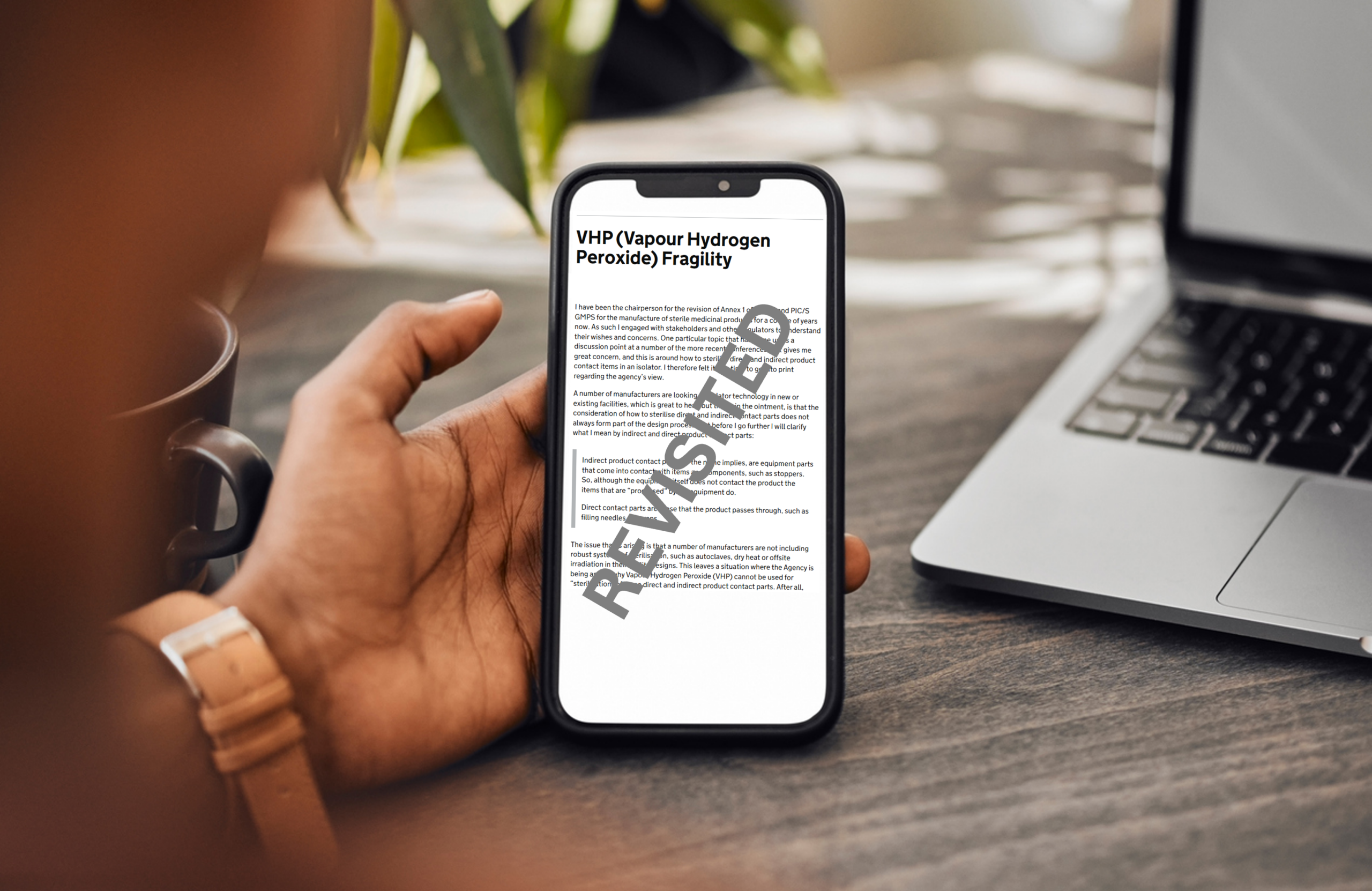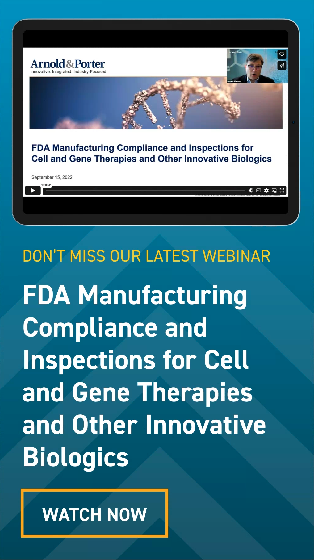In April 2018, whilst I was still an expert Inspector at the MHRA, I wrote a blog on vapour hydrogen peroxide. Having recently joined Lachman Consultants, I thought it would be an ideal time to revisit this subject to understand the current situation with this method and perhaps provide insight as to what Lachman could do to help the industry. The original blog was titled VHP (Vapour Hydrogen Peroxide Fragility – MHRA Inspectorate and it is fair to say that it caused a little bit of controversy! At the time of writing the blog, although manufacturers were moving towards isolators (which is, of course, a great move), I was concerned that there was also a direction being taken that they were reliant on the hydrogen peroxide process to “sterilise” their indirect-product-contact parts. The concern I expressed in the blog was specifically related to the use of VHP as a sterilant for isolator indirect-contact parts and whether VHP could be relied upon to give a consistent and effective sterilization process for these parts of the process. (Indirect-product-contact parts are equipment parts that do not contact the product but may come into contact with other sterilised surfaces, the sterility of which is critical to the overall product sterility (e.g., sterilised items, such as stopper bowls and guides) and sterilised components (as defined by Annex 1).) Further, the concern expressed was regarding the potential ineffectiveness of hydrogen peroxide as a vapour or a gas to be able to consistently sterilise surfaces that may then impact the sterility of the product, potentially putting the patient at risk due to ineffective sterilization of these indirect-contact parts in manufacturing isolators. This article revisits my original comments regarding VHP as a sterilant for indirect-contact parts, in light of updated information on its use.
The essence of my original concern was based on the fact that the hydrogen peroxide process (although capable of achieving a 6-log reduction of spores on biological indicators) could be significantly impacted by the method by which it was performed. Issues such as the conditions of the surfaces intended to be sterilized may reduce the effectiveness of the hydrogen peroxide process; for instance, if badly pitted or even rusted, they could present occluded surfaces and, in a worst-case scenario, could leave contamination present on indirect surfaces.
Also, the conditions in which the hydrogen peroxide process was performed and the criticality to the effectiveness of the process were not always fully understood by the user. Environmental conditions, such as temperature or humidity, could negatively impact the effectiveness of the decontamination process and, in some cases, changes in these parameters for the system in its entirety were not easily detectable. For instance, many years ago, I became aware of a VHP system that failed requalification with the root cause having been identified as a particularly hot summer in the UK (at the time, a rare event)! The inability to control physical parameters to render a system homogenous is still an area of concern. Anecdotally, I have recently heard of biological-indicator failures attributable to the indicators being placed on electrical equipment in the isolator with the failures due to the inherent heat in these systems preventing the correct condensation reaction from occurring. Other issues I’ve recently heard of include the failure to recognize occluded surfaces, especially those where it may not be direct surface-to-surface contact but there may be a small gap where the hydrogen peroxide cannot penetrate to any depth without modifications to the distribution system.
So, where are we now and what has made me want to revisit this topic? Well, unless you’ve been hiding in a cave, you will be aware that the updated Annex 1 (Eudralex Volume 4 and PIC/S GMP for the Manufacture of Sterile Medicinal Products) was published and is now fully effective as of the 25th August 2024. Also, in January 2024, the FDA published a guidance regarding the sterilization of medical devices (Submission and Review of Sterility Information in Premarket Notification (510(k)) Submissions for Devices Labeled as Sterile: Guidance for Industry and Food and Drug Administration Staff). Additionally, our knowledge of hydrogen-peroxide decontamination has improved, leading to different techniques for distribution of the agent.
If we look at the Annex 1 update, it does not mention hydrogen peroxide as a sterilant; VHP is only referenced as a decontaminant. Whilst I was the chair of the working group for the Annex 1 update, I was frequently asked why the working group didn’t explicitly rule out the use of hydrogen peroxide as a sterilant. My response was that it was difficult for a guidance to express an opinion on a negative; there are many different things that cannot be used as a sterilant. In the specific case of hydrogen peroxide, one could envisage certain scenarios where the environment is so closely controlled that it could be used consistently as a surface sterilant. If we look at the updated guidance for FDA 510k submission cited above, it centers around the sterilisation of surfaces of medical devices and this is one of those scenarios where the conditions (and the surfaces being sterilized) could have very close controls that provide a truly homogenous environment, leading to consistent sterilization of device surfaces. It should be noted, however, that this FDA Premarket Notification (501k) guidance also specifically prohibits the use of VHP for sterilization purposes during aseptic processing, such as pharmaceutical aseptic fills (see second bullet point listed under the guidance exclusions). So, whilst it is accepting of the use of hydrogen peroxide to sterilize medical devices in chambers that are highly controlled to give homogonous conditions, it specifically excludes its use as a sterilant for aseptic filling, e.g., for indirect-contact parts in isolators.
So, what appears to be the current trend? There’s a move to setting up equipment in isolators under enhanced conditions, such as steam sterilization of the stopper bowl, but then using increased protection of the setup, such as keeping the equipment covered and operators in a higher classification of gown that would not be typically seen in a grade C (ISO 8) environment, e.g., sterile one piece, hood, gloves, and goggles. Anecdotally, I am aware of regulators looking at this type of “enhanced” setup as an expectation. I have even heard of (again, anecdotally) regulators looking for smoke studies of this process and almost treating the setup prior to decontamination as an aseptic process in its own right. I have also heard regulators in open-forum discussions stating that their general expectation is for indirect-contact parts to be sterilized using a traditional method, such as moist heat, although if truly not possible they might be willing to accept a robust risk assessment of mitigating factors (as a last resort whilst engineering solutions are designed and implemented).
So, in conclusion, I am pleased that the MHRA issued my blog in 2018 as it started a dialogue and improvement in knowledge that I perceived was absent at the time of writing. We have far better knowledge and range of processes regarding hydrogen peroxide decontamination now but, for aseptic processing and specifically indirect-product-contact parts, it is still not generally considered a robust sterilization process. Regulators appear to be taking a view that indirect-contact parts cannot be sterilized by hydrogen peroxide and, therefore, they need to be sterilized traditionally and transferred to the isolator in highly controlled conditions.
So, where does that leave us? We need to make sure that we keep up the dialogue with regulators and equipment suppliers to continue to develop our knowledge and ensure that we all have the same understanding of the benefits (and potential issues). This includes items like redesigning component-handling equipment so that it is more ergonomic and easier to set up. We need to make sure that the companies that are trying to do the “right thing” are not unduly penalized for looking for measures that are too conservative and, therefore, prevent them from moving to isolators. Moving to isolators (especially from open processing) gives far better protection to patients in general so we need to avoid being too draconian and stifling innovation. However, we also need to keep the balance by having the appropriate control measures to ensure that we do what is right for patients (which is, of course, our ultimate goal).
There are still facilities that do not meet this expectation, however, and are still reliant on a hydrogen peroxide process to attain sterility of their indirect-contact equipment. So, what needs to happen in this scenario? The first step is performing an assessment of your current process to make sure that there is no risk to patient safety. This involves an in-depth knowledge of your process, equipment, and the hydrogen-peroxide system being used. This should be where you can then support your position in your Contamination Control Strategy (CCS). This can be difficult for some companies to perform and this is where Lachman may be able to help with a balanced and unbiased assessment of the risk that you have with your firm’s current practices. We can also help you with any future remediation plans that you will need to have in place to demonstrate that you will be moving to more robust methods of sterilisation. Regulators may accept an interim position of only using VHP on your indirect-contact parts (especially where there is risk of a product shortage) but it is unlikely that this would be accepted as a long-term strategy. It may also be necessary to open a dialogue with your regulatory stakeholders so that they are aware of your strategy, which Lachman can facilitate. Contact us at LCS@LachmanConsultants.com for a consultation!




